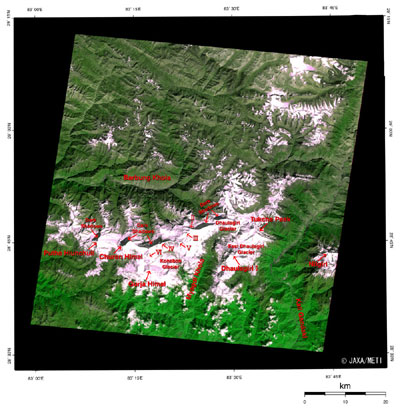Seen from Space 2005
Dhaulagiri, Himalayas: Eight-Thousand Meter Peak and Glaciers (Part 3)
The figure covers the area within Nepalese territory. The border with China is just above the figure. The area near the upper end of the figure appears as brownish olive green and light purple, representing the arid region of sparse vegetation that extends into Tibet. The area near the bottom of the figure appears as vivid green, indicating rich forest. Surrounding Dhaulagiri I, in the lower center of the figure, are Tukuche Peak (6,920m) on the northeast, Dhaulagiri II (7,751m), Dhaulagiri III (7,715m), Dhaulagiri V (7,618m), Dhaulagiri IV (7,661m), Dhaulagiri VI (7,268m), Gurja Himal (7,193m), Churen Himal (7,371m), and Putha Hiunchuli (7,246m). There are some glaciers in the higher altitude valleys in the Dhaulagiri Himal. On theupper right, the glaciers stand in line like the backbone of a whale and the small glacial lakes shown in purple accompany two wide glaciers. The area of the upper glacier is approximately 13sq km, and the lower one is approximately 8sq km (refer to the scale bar). In the reference, we find that "Dhaulagiri" originates in "Dhavalagiri" from the Sanskrit: "dhavala" means "white" and "giri" means "mountain." The growth and melting of glaciers are indices for measuring global warming. Some report that glaciers are easily affected by global warming in places at relatively low latitudes as well as at high altitudes, as in the Himalayas and Tibet. As glaciers retreat and contract, glacial lakes collapse, flooding downstream areas and causing sea levels to rise. Continued careful observation is therefore essential.
|
||||||||||||||||||





